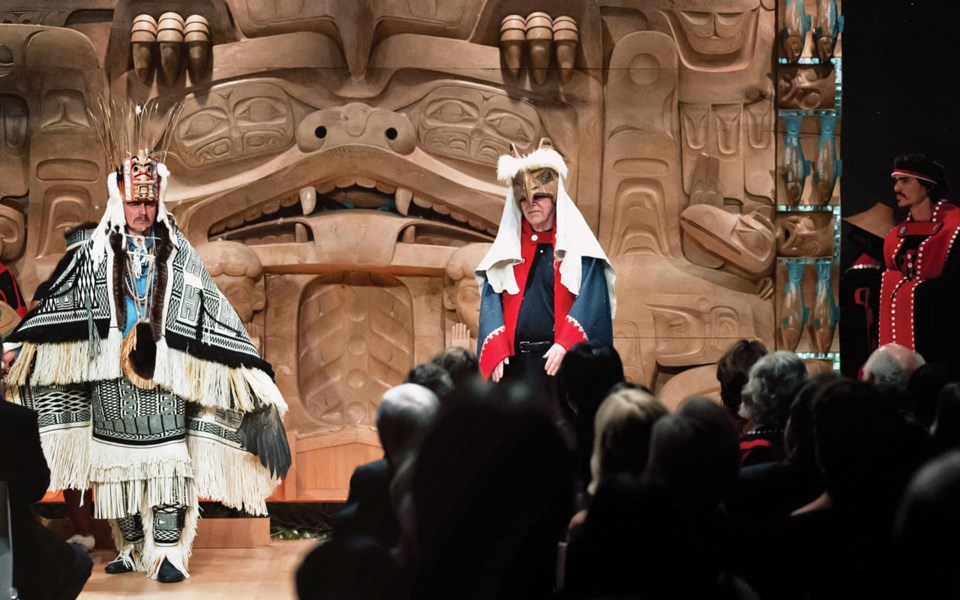Master carver James Hart's large-scale artwork, The Dance Screen (The Scream Too), has been the jaw-dropping piece that greets visitors at the entrance to the Audain Art Museum's collection since the institution opened two years ago.
Standing 4.79 metres by 3.23 metres, it depicts an eagle, a bear, orcas, a raven and, at the bottom, human figures, rimmed by swimming salmon with shimmery turquoise tails.
While the grand piece by the Haida artist and hereditary chief serves as a stunning work of art to view, it was always meant to be danced in a ceremony, featuring moveable pieces that allow entry and exit through it.
Last Saturday, Sept. 22, it came to life in a dancing-in performance for the very first time.
"The screen says to me, all of us, whether we have two feet or four, whether we have hair, scales, fur or feathers, we're all related to one another in one way or another in the great cycle of birth, life and death," Michael Audain, the museum founder who commissioned the piece, said after the ceremony. "Therefore, it's surely incumbent (on) us to treat each other with mutual respect."
Billed as a historic event, the ceremony included 100 guests (tickets were $1,200 per person with all funds going towards the museum's exhibits and educational programs) in the intimate Chrystal Gallery. It featured Hart and a group of Haida dancers who travelled to Whistler for the ceremony.
The event began with Hart, dressed in full regalia, removing the centre human figure from the sculpture, creating a portal. One man and four women emerged and as the man began to sing, the women released white, fluffy feathers that lingered in the air. Then, they turned around and joined the man in his slow, sombre song.
Soon after, two men with drums and another two carrying paddles lined with waving hair, emerged from the back entrance of the room and all the dancers congregated in front of the screen.
One of the women sprinkled the feathers onto Hart as he kneeled before her.
The hour-long ceremony—which was captured on video by filmmaker Helen Haig-Brown, who was commissioned to make a documentary about the event—included several different songs, instruments and regalia.
Halfway through, Hart stopped to speak. "(I want to) call a fellow forward, a fellow human being who's done wonderful work for all our people," he said. "We want to honour him with a song. It comes from one of my old grandfathers who just about drowned and people composed a song for him because they realized, if he drowned, how sad they'd all be, because he did so much work for the people. This song ... means, 'Where would we be today if it wasn't for you.'"
Hart then called Audain up and adorned him in an elaborate eagle mask, covering him with a blanket and bringing him in to dance. Later, Audain revealed how nerve-wracking the experience had been.
"I was told this afternoon that I'd have to be on duty that way and I have to tell you, when it was finished, I breathed a sigh," he told the audience afterwards.
The ceremony concluded with the dancers behind the screen. They blew feathers through holes towards the seated audience before Hart slowly, methodically, picked up the human figure and returned it to the centre of the piece.
"(The Dance Screen) is about the stream and what it means and it's about salmon and trying to bring attention to salmon and how important it is to us as a people and other creatures that survive from the salmon," Hart told the group before the event started. "The salmon has taken care of us for thousands of years and it's up to us to take care of them."
During the dinner that followed, more details emerged about the origins and history of the artwork. Audain explained that he initially commissioned Hart to carve a plaque that he could display on the wall of his cottage in Pender Harbour. When he travelled up to Haida Gwaii to visit Hart and see the progression of the piece, he saw "massive timbers" outside of his home. "(Hart and his carvers) were just starting in a way that the figures were crudely emerging. I said, 'Well, where is this going?'" Audain recalled, eliciting laughs. "It was obviously something a lot more than what I anticipated and because of that it didn't end up in our cottage."
Instead, the piece travelled to the Bill Reid Gallery in Vancouver then the Vancouver Art Gallery until the Audain Art Museum was constructed—with strengthened floors where the heavy dance screen would be displayed.
"Why I like to see the screen is because it indicates the skill of the masters of yesterday, 100 years ago," Audain said. "Those carvers, their skill has not been lost. There are a number of great carvers today, Jim being one of them."




